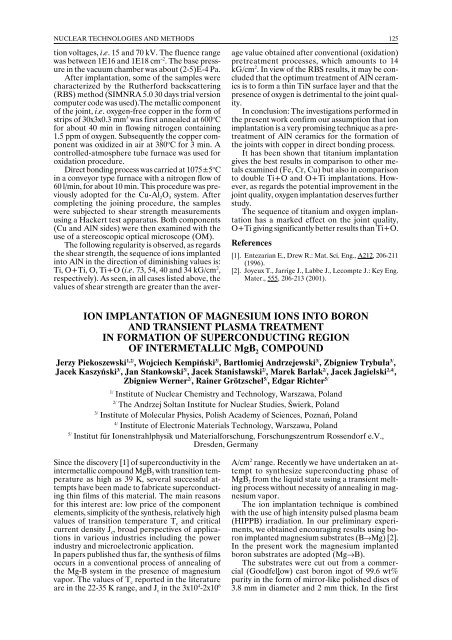annual report annual report annual report annual report 2005
annual report annual report annual report annual report 2005
annual report annual report annual report annual report 2005
You also want an ePaper? Increase the reach of your titles
YUMPU automatically turns print PDFs into web optimized ePapers that Google loves.
NUCLEAR TECHNOLOGIES AND METHODS 125<br />
tion voltages, i.e. 15 and 70 kV. The fluence range<br />
was between 1E16 and 1E18 cm –2 . The base pressure<br />
in the vacuum chamber was about (2-5)E-4 Pa.<br />
After implantation, some of the samples were<br />
characterized by the Rutherford backscattering<br />
(RBS) method (SIMNRA 5.0 30 days trial version<br />
computer code was used).The metallic component<br />
of the joint, i.e. oxygen-free copper in the form of<br />
strips of 30x3x0.3 mm 3 was first annealed at 600 o C<br />
for about 40 min in flowing nitrogen containing<br />
1.5 ppm of oxygen. Subsequently the copper component<br />
was oxidized in air at 380 o C for 3 min. A<br />
controlled-atmosphere tube furnace was used for<br />
oxidation procedure.<br />
Direct bonding process was carried at 1075±5 o C<br />
in a conveyor type furnace with a nitrogen flow of<br />
60 l/min, for about 10 min. This procedure was previously<br />
adopted for the Cu-Al 2 O 3 system. After<br />
completing the joining procedure, the samples<br />
were subjected to shear strength measurements<br />
using a Hackert test apparatus. Both components<br />
(Cu and AlN sides) were then examined with the<br />
use of a stereoscopic optical microscope (OM).<br />
The following regularity is observed, as regards<br />
the shear strength, the sequence of ions implanted<br />
into AlN in the direction of diminishing values is:<br />
Ti, O+Ti, O, Ti+O (i.e. 73, 54, 40 and 34 kG/cm 2 ,<br />
respectively). As seen, in all cases listed above, the<br />
values of shear strength are greater than the aver-<br />
age value obtained after conventional (oxidation)<br />
pretreatment processes, which amounts to 14<br />
kG/cm 2 . In view of the RBS results, it may be concluded<br />
that the optimum treatment of AlN ceramics<br />
is to form a thin TiN surface layer and that the<br />
presence of oxygen is detrimental to the joint quality.<br />
In conclusion: The investigations performed in<br />
the present work confirm our assumption that ion<br />
implantation is a very promising technique as a pretreatment<br />
of AlN ceramics for the formation of<br />
the joints with copper in direct bonding process.<br />
It has been shown that titanium implantation<br />
gives the best results in comparison to other metals<br />
examined (Fe, Cr, Cu) but also in comparison<br />
to double Ti+O and O+Ti implantations. However,<br />
as regards the potential improvement in the<br />
joint quality, oxygen implantation deserves further<br />
study.<br />
The sequence of titanium and oxygen implantation<br />
has a marked effect on the joint quality,<br />
O+Ti giving significantly better results than Ti+O.<br />
References<br />
[1]. Entezarian E., Drew R.: Mat. Sci. Eng., A212, 206-211<br />
(1996).<br />
[2]. Joyeux T., Jarrige J., Labbe J., Lecompte J.: Key Eng.<br />
Mater., 555, 206-213 (2001).<br />
ION IMPLANTATION OF MAGNESIUM IONS INTO BORON<br />
AND TRANSIENT PLASMA TREATMENT<br />
IN FORMATION OF SUPERCONDUCTING REGION<br />
OF INTERMETALLIC MgB 2 COMPOUND<br />
Jerzy Piekoszewski 1,2/ , Wojciech Kempiński 3/ , Bartłomiej Andrzejewski 3/ , Zbigniew Trybuła 3/ ,<br />
Jacek Kaszyński 3/ , Jan Stankowski 3/ , Jacek Stanisławski 2/ , Marek Barlak 2/ , Jacek Jagielski 2,4/ ,<br />
Zbigniew Werner 2/ , Rainer Grötzschel 5/ , Edgar Richter 5/<br />
1/<br />
Institute of Nuclear Chemistry and Technology, Warszawa, Poland<br />
2/<br />
The Andrzej Soltan Institute for Nuclear Studies, Świerk, Poland<br />
3/<br />
Institute of Molecular Physics, Polish Academy of Sciences, Poznań, Poland<br />
4/<br />
Institute of Electronic Materials Technology, Warszawa, Poland<br />
5/<br />
Institut für Ionenstrahlphysik und Materialforschung, Forschungszentrum Rossendorf e.V.,<br />
Dresden, Germany<br />
Since the discovery [1] of superconductivity in the<br />
intermetallic compound MgB 2 with transition temperature<br />
as high as 39 K, several successful attempts<br />
have been made to fabricate superconducting<br />
thin films of this material. The main reasons<br />
for this interest are: low price of the component<br />
elements, simplicity of the synthesis, relatively high<br />
values of transition temperature T c and critical<br />
current density J c , broad perspectives of applications<br />
in various industries including the power<br />
industry and microelectronic application.<br />
In papers published thus far, the synthesis of films<br />
occurs in a conventional process of annealing of<br />
the Mg-B system in the presence of magnesium<br />
vapor. The values of T c <strong>report</strong>ed in the literature<br />
are in the 22-35 K range, and J c in the 3x10 4 -2x10 6<br />
A/cm 2 range. Recently we have undertaken an attempt<br />
to synthesize superconducting phase of<br />
MgB 2 from the liquid state using a transient melting<br />
process without necessity of annealing in magnesium<br />
vapor.<br />
The ion implantation technique is combined<br />
with the use of high intensity pulsed plasma beam<br />
(HIPPB) irradiation. In our preliminary experiments,<br />
we obtained encouraging results using boron<br />
implanted magnesium substrates (B→Mg) [2].<br />
In the present work the magnesium implanted<br />
boron substrates are adopted (Mg→B).<br />
The substrates were cut out from a commercial<br />
(Goodfellow) cast boron ingot of 99.6 wt%<br />
purity in the form of mirror-like polished discs of<br />
3.8 mm in diameter and 2 mm thick. In the first
















